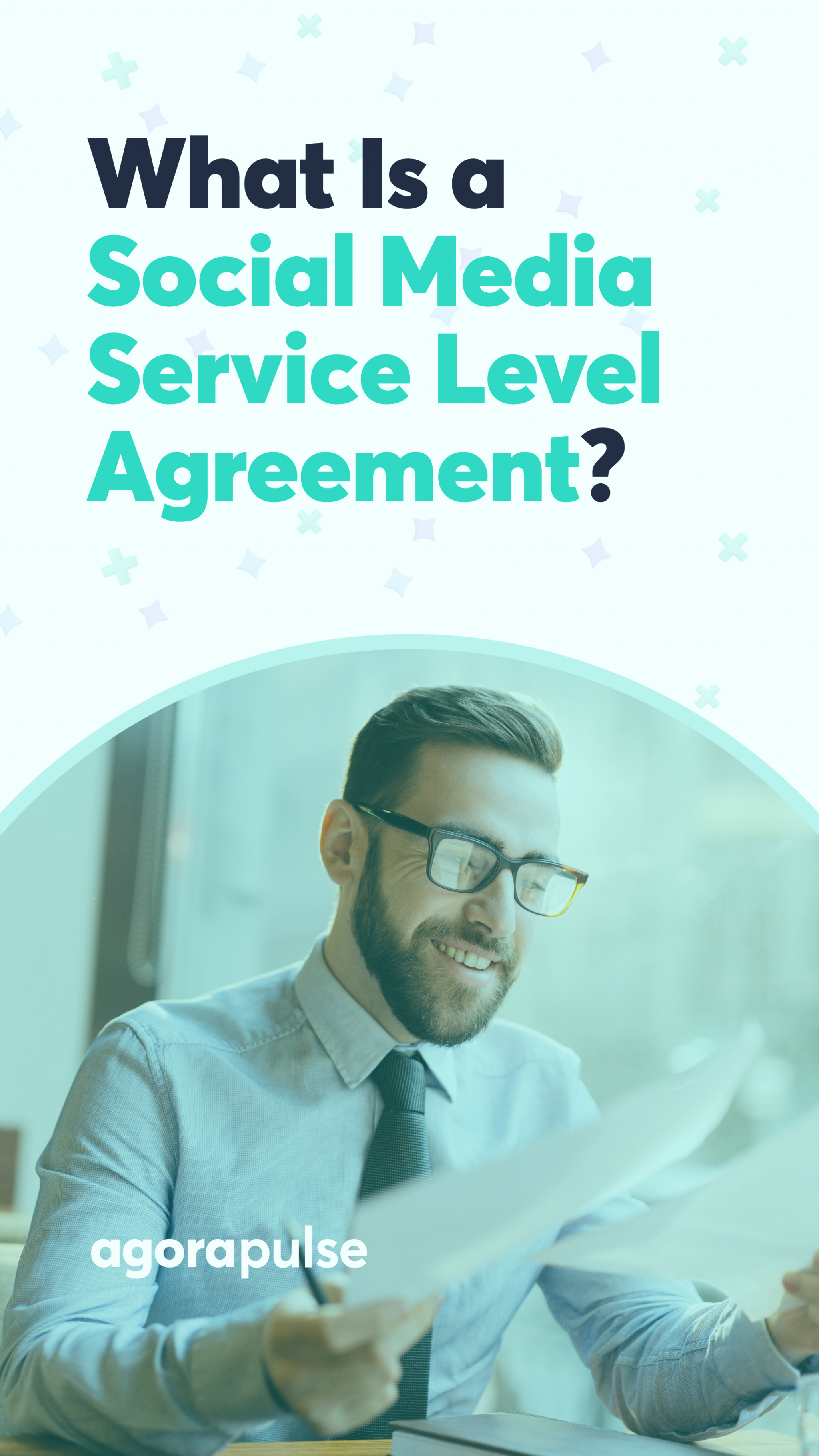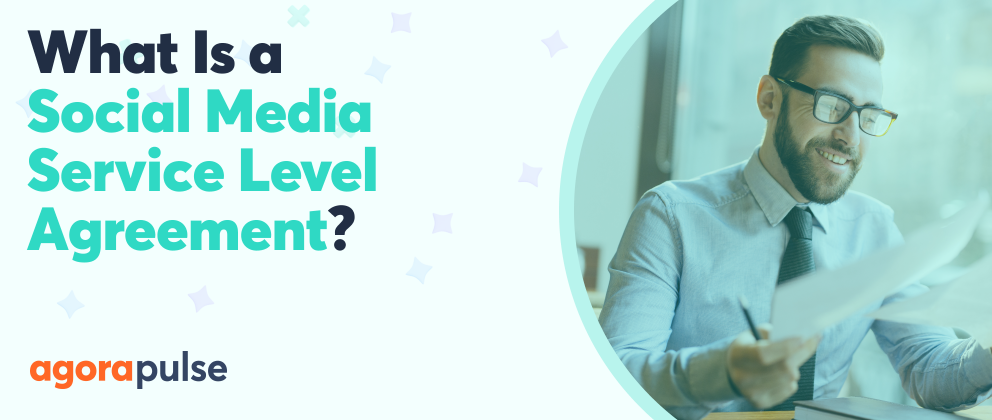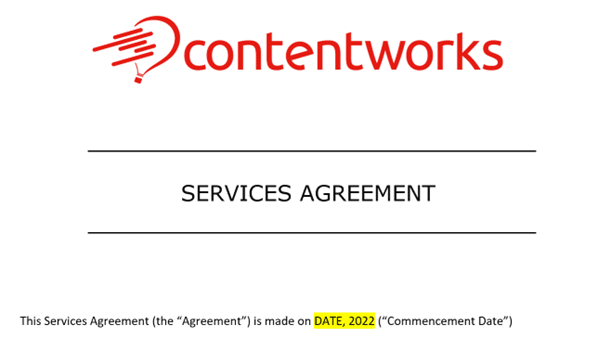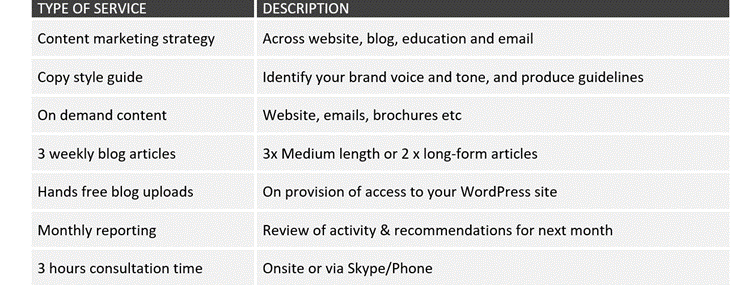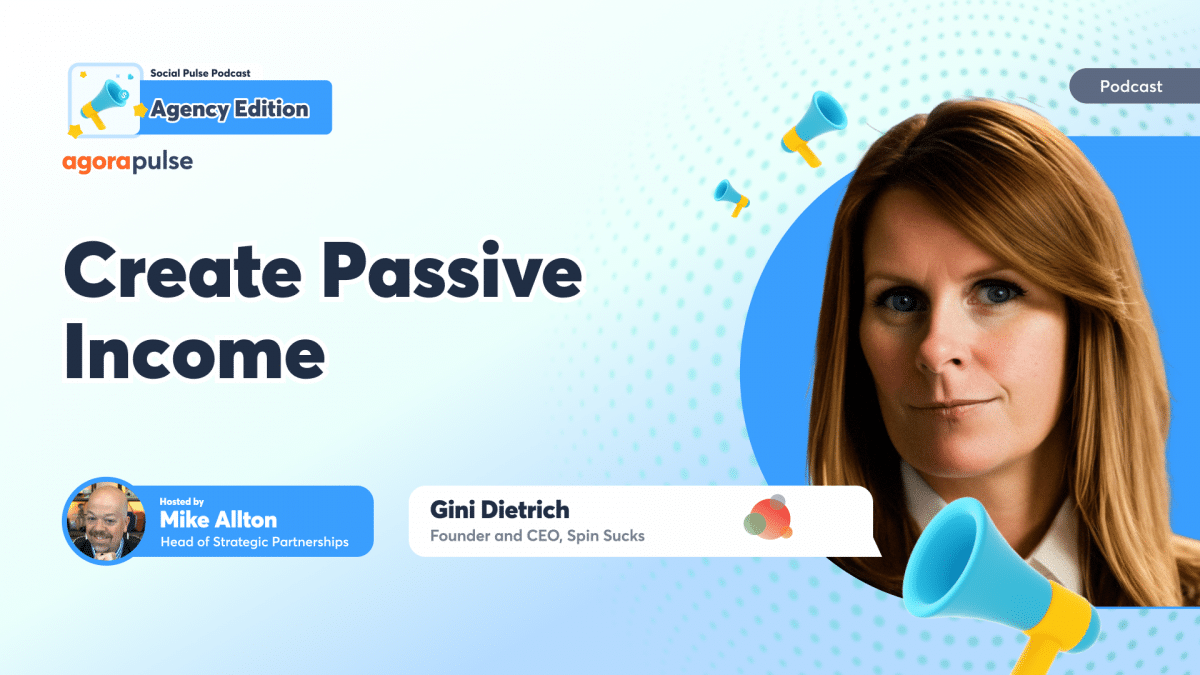As creatives, none of us really love service agreements. They aren’t part of the social media marketing agency fun. But they are necessary. Social media service level agreements (SLAs) are a critical component of any outsourcing and vendor contract.
I’m going to walk you through a social media service level agreement. We’re going to look at what a social media service level agreement is, why you need it, and what could go into it.
What Is a Social Media Service Level Agreement?
A social media service level agreement essentially defines the level of service expected by a client from an agency. It also lays out the expectations of the social media marketing agency.
Social media service level agreements will vary from agency to agency, but they should cover key parameters for the protection of both parties. And it’s important to emphasize that the agreement is for both parties and should be fair.
SLAs usually are between companies and external suppliers, but I have also known them to be between two departments in the same company.
Why Does Your Business Need a Social Media Service Level Agreement?
An SLA is essential in ensuring both parties are on the same page in terms of standards and service.
Failure to implement a proper service level agreement can lead to:
- Misunderstandings on both sides about the services provided and results delivered
- Nonpayment, late payment, poor communication, misuse of communication, and other undesirable behaviors
- Excess time spent recapping the agreement. That is especially true if the original stakeholder leaves and you need to explain your services to a new stakeholder.)
- Missed KPIs and dissatisfaction with services. If left unchecked, that will ensure an agency loses the client.
- In the worst-case scenario, legal action can be the result of an improper or non-existent service level agreement. This is especially true when dealing with large corporations.
Service Level Agreement Basics
SLAs vary between the very simple and the very complex.
Let’s start at the beginning with the essentials that need to be in your agreement.
The name(s) of the client and the agency and establishing the foundation of the agreement
X Agency will provide social media marketing services to X company from X date.
A page for scope of services to be covered
Many agencies prefer to add this as an appendix therefore leaving the core contract template as standard. This appendix should be much more detailed and include metrics, expectations and deliverables.
Service provider responsibilities
Work with X client to develop a comprehensive strategy and planning document. Provide social media management solutions. Offer ongoing strategy and guidance. Meet online each month to discuss campaign ideas.
This section does not have to detail every aspect of your involvement, it is more of a synopsis. Remember that anything you detail in your SLA, you need to deliver.
Client responsibilities
Again, this is a synopsis and doesn’t need to detail everything. To keep X Agency updated with internal events and organizational updates. To promptly respond to emails and questions pertaining to the scope of work. To ensure key stakeholders are available for scheduled meetings.
Agencies can be clear that a client’s failure to adhere to this may impact deliverables and metrics.
Specify liability
Working with clients that are regulated by legal or compliance may require you to outline your/their liability. For example, if content is approved by the client and then incurs a fine or complaint, this would be the client’s responsibility.
Payment terms and conditions
As an agency or contractor, you will probably have standard payment terms. You might also want to include a late payment fee.
X Agency shall produce a valid invoice once a month. The fees shall be paid to X Agency within a period 30 calendar days upon receipt of the said invoices. A late payment charge will apply for each day past the 30th day at a rate of 1% of the invoice amount per day until the payment is settled.
An NDA (non-disclosure agreement)
This will be in a section pertaining to confidentiality. The Parties have signed the Standard Non-Disclosure Agreement that will form an equal and integral part of this Agreement.
Notice period
This should be in your service level agreement to outline what will happen if either party wants to withdraw from the agreement. You might specify a notice period of several months. Although this is very difficult to enforce.
Ownership
There should also be a section on intellectual property and ownership of designs, files and ideas following the end of the agreement. Generally speaking, if the client does not owe monies, then any work produced during the agreement will belong to them.
Services not offered
Specific services that are not offered should also be clearly defined to avoid confusion and eliminate room for assumptions from other parties. For example, a client might assume a social media management agency is responding to direct social media messages from clients. If you’re not, you should state this in the SLA.
Signatures
Key stakeholders from both parties must sign the document to show their approval at the end of the agreement. This section should also be dated. If you revise the agreement at any time, the signatures must be obtained again, and the dates edited.
Service Level Agreement–Digging Deeper
Most agencies or contractors will add an appendix or detailed SLA for each client. That sets out the specific tasks, metrics and deliverables. It’s helpful to have this in print and signed so that you can refer back to it as the cornerstone of your agreement with the client.
Outline the deliverables
To begin you can outline the specific deliverables. Here’s an example from one of our SLAs. This is an overview of the specific services that this client will receive. We would then provide more depth to each item.
The time your client is entitled to
Agencies will measure this differently and some define this metric in terms of work delivered rather than hours.
However, it’s also good to include:
- Your working hours and contact availability – e.g. 8 AM – 4 PM (EST)
- The average turnaround time for new requests. For example, a new blog request will take between 2-5 working days to deliver.
- Some SLAs will specify a percentage of availability. It’s not uncommon to see a term like 999% uptime between X hours. This covers the agency for unavailability.
- Acceptable and official methods of contact for your agency, such as email or Skype. This also prevents abuse of social media chats on personal networks. “We cannot guarantee response time when clients submit requests via voicemail, social media chat or text message” is an acceptable clause to include.
- Additional rates or charges for work that takes place out of hours or above the allotted monthly time. Or for work that is on a faster than agreed turnaround time
Client KPIs
Agreed client KPIs are a good thing to include in your service level agreement. Of course, you should only include the KPIs that pertain to your actual involvement and actions that are within your control.
Example: A KPI that centers on improving keywords/web ranking when the client is writing their own content, is not something you should include in your agreement. However, improving social media engagement when you are creating the social media content, providing the direction and managing the channels, is within your scope. KPIs should find a good balance between being specific but also achievable. Typical KPIs for social media would center on:
- Reach
- Engagement
- Leads
- Conversions
- Brand Awareness
Include reporting
Reporting should be included in your service level agreement because clients will want to see how you are delivering against their specific requirements.
Your SLA should provide information on the kind of social media or marketing report that will be delivered and when your client should expect it.
Generally, clients like to receive their reports regularly and at the end of the month.
As director of Contentworks Agency, I also specify that we use Agorapulse as a third-party monitoring and reporting tool. This is important, especially for companies that have high levels of security and will be aware of any additional apps accessing their social media channels.
Choose measurements that are easily collected
The core KPIs of Reach, Engagement, Leads, Conversions and Brand Awareness are easily harvested by Agorapulse when you connect your client’s socials. As an agency, it’s not ideal to commit to measuring elements that are outside of your control.
Example: If the client requires monitoring of web traffic metrics, they need to provide you with access to their website and Google analytics. You would need to be paid and contracted for this service.
Below you can see the metrics easily pulled from a client’s socials via Agorapulse. Here, you can be transparent about exact numbers and benchmarked increases (or decreases) over time.
Tip: Avoid including an excessive number of metrics. Too many metrics make it more likely that you will breach your agreement with the client. Additionally, you may find it difficult to monitor and report on them with consistency. From experience, clients don’t want that either. Keep things simple.
Create a baseline
A great thing about Agorapulse is that it leaves no room for ambiguity. You can easily run comparisons of client socials before and after you begin managing it. It’s important to set a baseline for the “before” in your SLA so that your client understands where you’re starting from. We usually run an initial report when we begin work with a client. This will show them factors like fan count, engagement rate, likes, reach and content popularity. This then clearly demonstrates your impact on the ongoing metrics.
Create Social Media Reports That People Will Actually Read (and Like)
Collaborate with your client
Usually, the agency will draw up the service level agreement and the client will sign it. But sometimes the client will request edits to the agreement. It’s good to remember that the agreement is for both parties, and everyone should be happy with it.
If the changes are reasonable then you can edit and resend the agreement. The agreement should be in a PDF or non-editable format though. That means any changes will be agreed by both parties, and nothing can be secretly added.
How Often Should We Revise Our Service Level Agreement?
Service level agreements should be kept up to date and reflect the current scope of work between an agency and client.
That doesn’t mean you need to replace them yearly if your services didn’t change.
However, as clients grow and their plans shift, the work required from an agency will often change, too. In that case, the service level agreement needs to be updated.
When to update the social media service level agreement
Here are some reasons why you might need to update the agreement:
- The client’s needs have changed
For example, they hired a content writer in house. Now, they just need you to manage the posts that he/she has written. This will change the agreement, the price, and your responsibilities and commitments to metrics. You’re not going to assure the same results if you are not responsible for the content. - Tech has changed
If you or the client is using a different platform or communication method, then it’s a good idea to update your SLA. Similarly, if the client removed or added a social media network you should provide a dated update. - KPIs have changed
This is the most likely scenario, especially if you have been working with the client for a long time. Ideally you will be aware of the shift in their direction and may proactively suggest an updated SLA.
Remember, you cannot contract outside the law. That means the agreement must contain clauses that are legally recognized and enforceable in your country.
Once you have drawn up your SLA template, ask a lawyer to review it and ensure it is acceptable and enforceable. After this, it can become your standard (and editable) template for future clients.
Check out our free trial of Agorapulse to help you schedule, track, and measure all your social media efforts.
